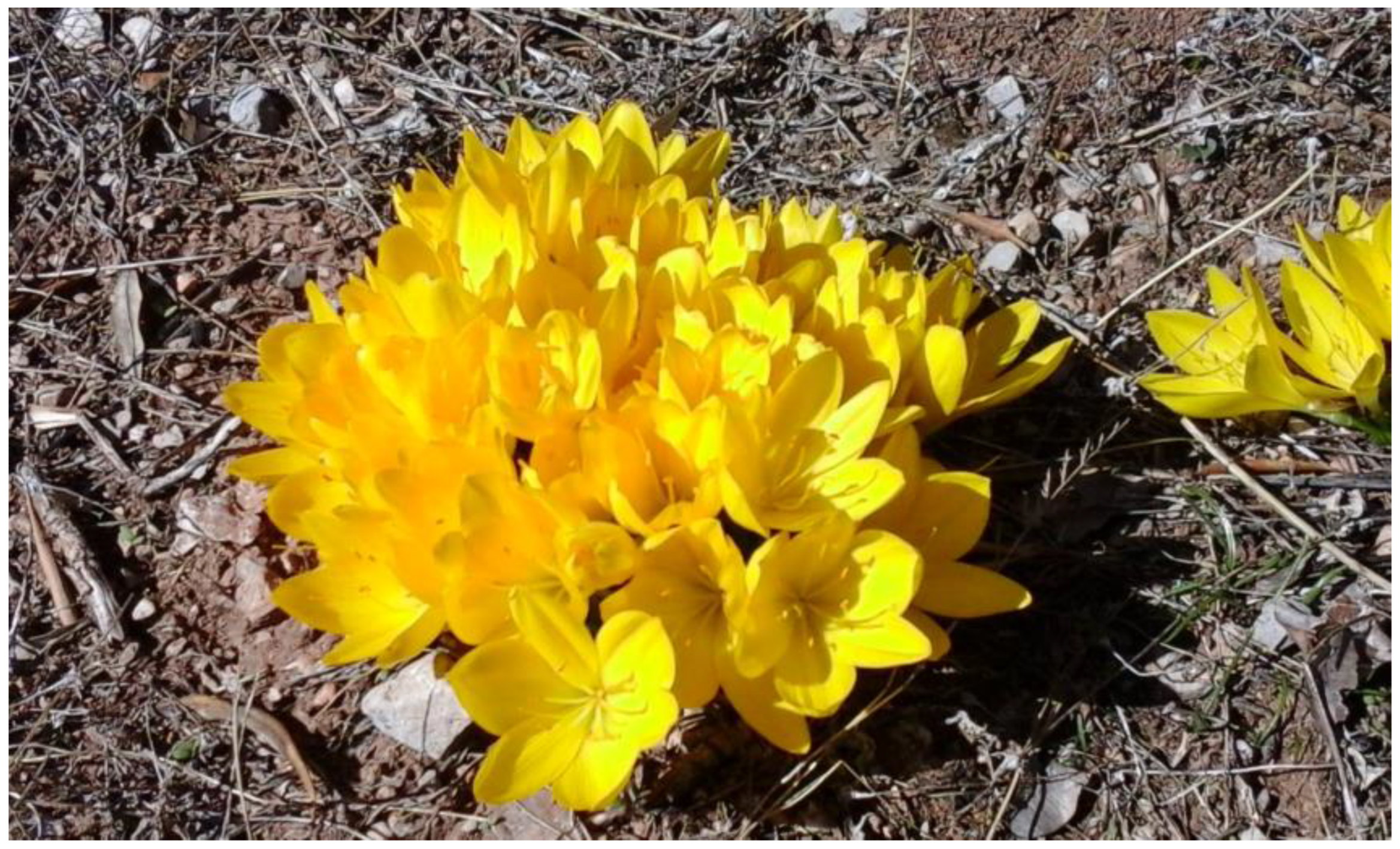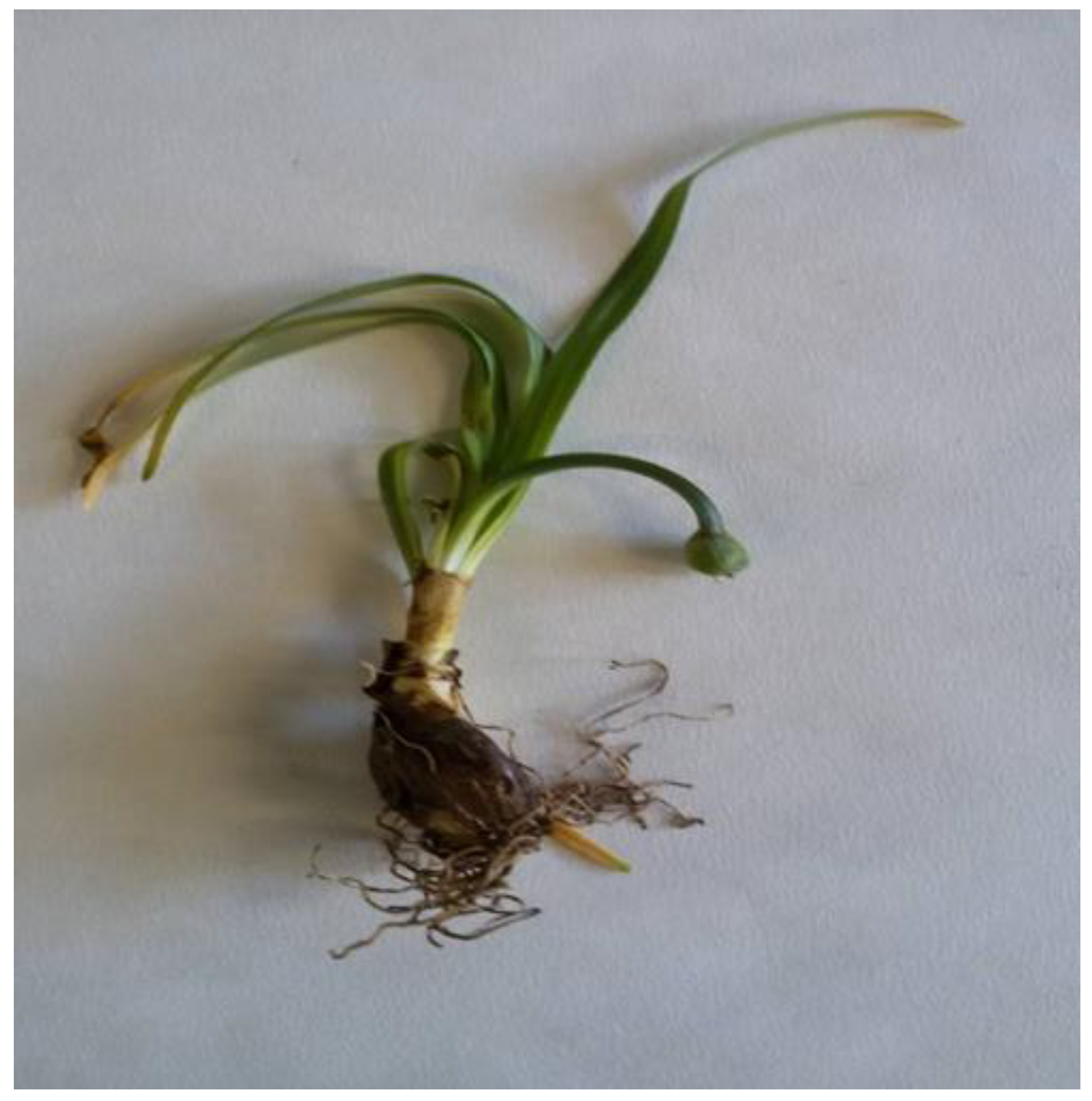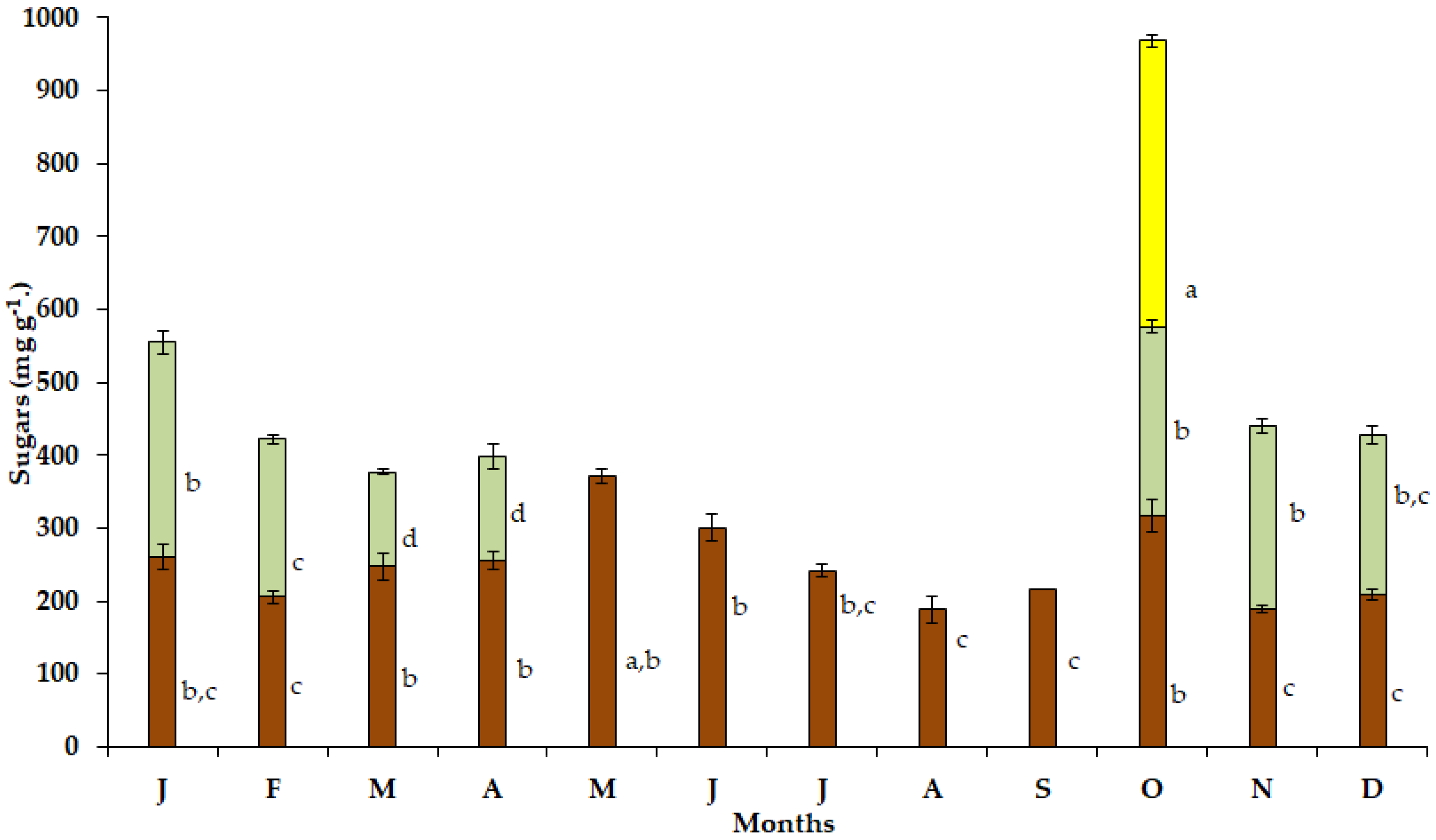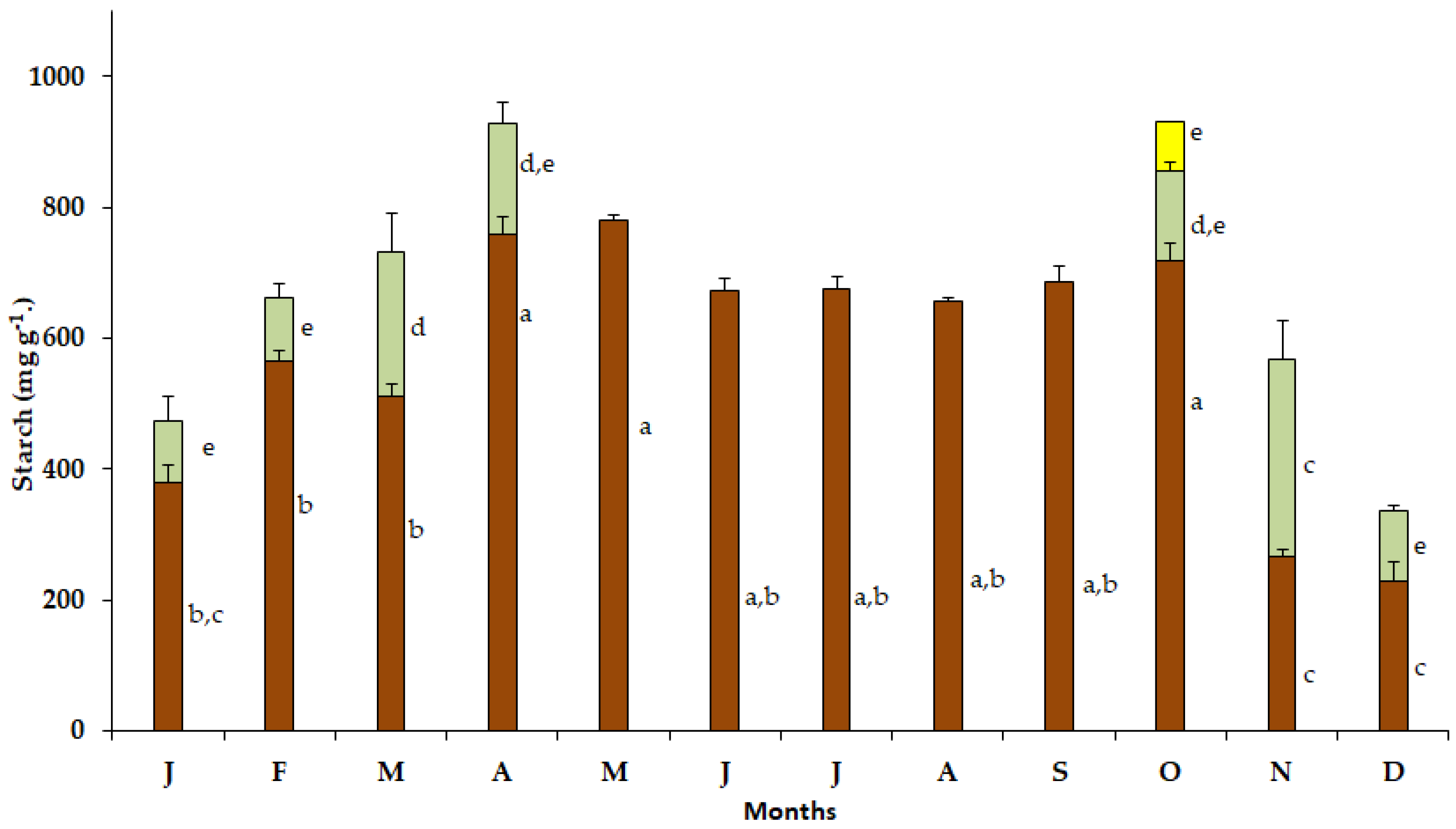Unraveling Seasonal Allocation of Soluble Sugars, Starch and Proline in Sternbergia lutea
Abstract
:1. Introduction
2. Results
2.1. Soluble Sugars
2.2. Starch
2.3. Proline
2.4. Leaf Water Status
3. Discussion
4. Materials and Methods
4.1. Research Site
4.2. Total Sugars and Starch
4.3. Free Proline
4.4. Leaf Water Status
4.5. Statistical Analysis
5. Conclusions
Supplementary Materials
Author Contributions
Funding
Data Availability Statement
Conflicts of Interest
References
- International Plant Name Index. Available online: https://www.ipni.org/?q=Sternbergia (accessed on 3 May 2023).
- Gage, E.; Wilkin, P.A. Morphometric study of species delimitation in Sternbergia lutea (Alliaceae, Amaryllidoideae) and its allies S. sicula and S. greuteriana. Bot. J. Linn. Soc. 2008, 158, 460–469. [Google Scholar] [CrossRef]
- Ilieva, I.A.; Ilieva, I. Names of botanical genera dedicated to genuine persons. World J. Biol. Pharm. Health Sci. 2022, 12, 110–129. [Google Scholar] [CrossRef]
- Frignani, F.; Geri, F.; Gestri, G.; Peruzzi, L. Distribution of the genus Sternbergia Waldst. & Kit. (Amaryllidaceae) in Tuscany (central Italy). Atti Soc. tosc. Sci. Nat. Mem. Serie B 2009, 116, 67–71. [Google Scholar]
- Capotorti, G.; Del Vico, E.; Lattanzi, E.; Tilia, A.; Celesti-Grapow, L. Exploring biodiversity in a metropolitan area in the Mediterranean region: The urban and suburban flora of Rome (Italy). Plant Biosyst. 2013, 147, 174–185. [Google Scholar] [CrossRef]
- Potenza, G.; Vairo, F.; Castronuovo, D.; Fascetti, S.; Candido, V. Use of native geophytes of ornamental interest: The case study of Sternbergia lutea (L.) Ker. Gawl. Ex Spreng. Biol. Life Sci. Forum 2021, 11, 34. [Google Scholar] [CrossRef]
- Hadas, R.; Kamenetsky, R.; Fragman-Sapir, O. Ex-situ conservation of Israel’s native geophytes—Source for development of new ornamental crops. Isr. J. Plant Sci. 2009, 57, 277–285. [Google Scholar] [CrossRef]
- Lehmann, S.; Funck, D.; Szabados, L.; Rentsch, D. Proline metabolism and transport in plant development. Amino Acids 2010, 39, 949–962. [Google Scholar] [CrossRef] [PubMed]
- Verbruggen, N.; Hermans, C. Proline accumulation in plants: A review. Amino Acids 2008, 35, 753–759. [Google Scholar] [CrossRef]
- Szabados, L.; Savouré, A. Proline: A multifunctional amino acid. Trends Plant Sci. 2010, 15, 89–97. [Google Scholar] [CrossRef]
- Rhizopoulou, S.; Diamantoglou, S.; Passiakou, L. Free proline accumulation in leaves, stems and roots of four Mediterranean native phrygana species. Acta Oecol. 1990, 11, 585–593. [Google Scholar]
- Kaur, G.; Asthir, B. Proline: A key player in plant abiotic stress tolerance. Biol. Plant. 2015, 59, 609–619. [Google Scholar] [CrossRef]
- Ghosh, U.K.; Islam, M.N.; Siddiqui, M.N.; Cao, X.; Khan, M.A.R. Proline, a multifaceted signalling molecule in plant responses to abiotic stress: Understanding the physiological mechanisms. Plant Biol. 2022, 24, 227–239. [Google Scholar] [CrossRef] [PubMed]
- Liang, X.; Zhang, L.; Natarajan, S.K.; Becker, D.F. Proline mechanisms of stress survival. ARS 2013, 19, 998–1011. [Google Scholar] [CrossRef] [PubMed]
- Hare, P.D.; Cress, W.A. Metabolic implications of stress-induced proline accumulation in plants. Plant Growth Regul. 1997, 21, 79–102. [Google Scholar] [CrossRef]
- Dafni, A.; Shmida, A.; Avishai, M. Leafless autumnal-flowering geophytes in the Mediterranean region—Phytogeographical, ecological and evolutionary aspects. Plant Syst. Evol. 1981, 137, 181–193. [Google Scholar] [CrossRef]
- Boeken, B.; Guttermann, Y. The annual cycle of Sternbergia clusiana of the Negev desert. J. Arid Environ. 1989, 16, 271–282. [Google Scholar] [CrossRef]
- Pouris, J.; Meletiou-Christou, M.S.; Chimona, C.; Rhizopoulou, S. Seasonal functional partitioning of carbohydrates and proline among plant parts of the sand daffodil. Agronomy 2020, 10, 539. [Google Scholar] [CrossRef]
- Pouris, J.; Levizou, E.; Karatassiou, M.; Meletiou-Christou, M.S.; Rhizopoulou, S. The influence of the partitioning of sugars, starch, and free proline in various organs of Cyclamen graecum on the biology of the species and its resistance to abiotic stressors. Plants 2022, 11, 1254. [Google Scholar] [CrossRef]
- Rhizopoulou, S.; Pantis, J.D.; Triantafylli, E.; Vokou, D. Ecophysiological adaptations of Asphodelus aestivus to Mediterranean climate periodicity: Water relations and energetic status. Ecography 1997, 20, 626–633. [Google Scholar] [CrossRef]
- Franková, L.; Cibírová, K.; Bóka, K.; Gašparíková, O.; Pšenák, M. Protein reutilization in corms of Colchicum autumnale. Biologia 2006, 61, 97–102. [Google Scholar]
- Shane, M.W.; Pate, J.S. Survival strategies of the root tuberous geophyte Chamaescilla corymbosa in a Mediterranean-climate rock-outcrop environment. Aust. J. Bot. 2015, 63, 497–511. [Google Scholar]
- Diamantoglou, S.; Rhizopoulou, S. Free proline accumulation in sapwood, bark and leaves of three evergreen sclerophylls and a comparison with an evergreen conifer. J. Plant Physiol. 1992, 140, 361–365. [Google Scholar]
- Lansac, A.R.; Zaballos, J.P.; Martin, A. Seasonal water potential changes and proline accumulation in Mediterranean shrubland species. Vegetatio 1994, 113, 141–154. [Google Scholar] [CrossRef]
- Bach, A.; Sochacki, D. Propagation of ornamental geophytes, physiology and management systems. In Ornamental Geophytes: From Basic Science to Sustainable Production; CRC Press: Boca Paton, FL, USA, 2013; pp. 261–286. [Google Scholar]
- Manafi, H.; Nazari, F. The effect of storage temperature on biochemical changes in autumn daffodil bulbs (Sternbergia lutea (L.) Ker Gawl. ex Spreng.) and its impact on interactions with photoperiod and morphological indices. Acta Physiol. Plant. 2021, 43, 1–14. [Google Scholar] [CrossRef]
- Sheikh, F.R.; Jose-Santhi, J.; Kalia, D.; Singh, K.; Singh, R.K. Sugars as the regulators of dormancy and sprouting in geophytes. Ind. Crops Prod. 2022, 189, 115817. [Google Scholar] [CrossRef]
- Benkeblia, N.; Shiomi, N. Chilling effect on soluble sugars, respiration rate, total phenolics, peroxidase activity and dormancy of onion bulbs. Sci. Agric. 2004, 61, 281–285. [Google Scholar] [CrossRef]
- Parkin, J. II. Contributions to our knowledge of the formation, storage, and depletion of carbohydrates in monocotyledons. Philos. Trans. R. Soc. London Series B 1899, 191, 35–79. [Google Scholar]
- Shin, K.S.; Chakrabarty, D.; Paek, K. Sprouting rate, change of carbohydrate contents and related enzymes during cold treatment of lily bulblets regenerated in vitro. Sci. Hortic. 2002, 96, 195–204. [Google Scholar] [CrossRef]
- Theron, K.I.; Jacobs, G. Changes in carbohydrate composition of the different bulb components of Nerine bowdenii W. Watson (Amaryllidaceae). J. Am. Soc. Hortic. Sci. 1996, 12, 343–346. [Google Scholar] [CrossRef]
- Passioura, J.B. Water transport in and to roots. Annu. Rev. Plant Physiol. Plant Mol. Biol. 1988, 39, 245–265. [Google Scholar] [CrossRef]
- Porcel, R.; Ruiz-Lozano, J.M. Arbuscular mycorrhizal influence on leaf water potential, solute accumulation, and oxidative stress in soybean plants subjected to drought stress. J. Exp. Bot. 2004, 55, 1743–1750. [Google Scholar] [CrossRef] [PubMed]
- Raymond, M.J.; Smirnoff, N. Proline metabolism and transport in maize seedlings at low water potential. Ann. Bot. 2002, 89, 813–823. [Google Scholar] [CrossRef] [PubMed]
- Dubois, M.; Gilles, K.A.; Hamilton, J.K.; Rebers, P.T.; Smith, F. Colorimetric method for determination of sugars and related substances. Anal. Chem. 1956, 28, 350–356. [Google Scholar] [CrossRef]
- Buysse, J.A.N.; Merckx, R. An improved colorimetric method to quantify sugar content of plant tissue. J. Exp. Bot. 1993, 44, 1627–1629. [Google Scholar] [CrossRef]
- Meletiou-Christou, M.S.; Rhizopoulou, S. Leaf functional traits of four evergreen species growing in Mediterranean environmental conditions. Acta Physiol. Plant. 2017, 39, 1–13. [Google Scholar] [CrossRef]
- Bates, L.S.; Waldren, R.A.; Teare, I.D. Rapid determination of free proline for water-stress studies. Plant Soil 1973, 39, 205–207. [Google Scholar] [CrossRef]
- Ain-Lhout, F.; Zunzunegui, M.; Diaz Barradas, M.C.; Tirado, R.; Clavijo, A.; Garcia Novo, F. Comparison of proline accumulation in two Mediterranean shrubs subjected to natural and experimental water deficit. Plant Soil 2001, 230, 175–183. [Google Scholar] [CrossRef]
- Richter, H. A diagram for the description of water relations in plant cells and organs. J. Exp. Bot. 1978, 29, 1197–1203. [Google Scholar] [CrossRef]
- Rhizopoulou, S.; Meletiou-Christou, M.S.; Diamantoglou, S. Water relations for sun and shade leaves of four Mediterranean evergreen sclerophylls. J. Exp. Bot. 1991, 42, 627–635. [Google Scholar] [CrossRef]
- Meletiou-Christou, M.S.; Rhizopoulou, S. Constraints of photosynthetic performance and water status of four evergreen species co-occurring under field conditions. Bot. Stud. 2012, 53, 325–334. [Google Scholar]






| Months | Ψw (MPa) | Ψs (MPa) | Ψp (MPa) |
|---|---|---|---|
| January | −0.50 ± 0.05 a,b | −0.76 ± 0.04 a,b | 0.26 ± 0.02 b |
| February | −0.50 ± 0.02 a,b | −0.70 ± 0.06 a | 0.20 ± 0.03 c |
| March | −0.57 ± 0.04 b | −0.72 ± 0.02 a | 0.15 ± 0.01 c |
| April | −0.67 ± 0.03 c | −0.70 ± 0.04 a | 0.03 ± 0.00 d |
| May | |||
| June | |||
| July | |||
| August | |||
| September | |||
| October | −0.45 ± 0.03 a | −0.71 ± 0.06 a | 0.26 ± 0.05 b |
| November | −0.46 ± 0.02 a | −0.78 ± 0.04 b | 0.32 ± 0.03 a |
| December | −0.45 ± 0.03 a | −0.80 ± 0.05 b | 0.35 ± 0.02 a |
Disclaimer/Publisher’s Note: The statements, opinions and data contained in all publications are solely those of the individual author(s) and contributor(s) and not of MDPI and/or the editor(s). MDPI and/or the editor(s) disclaim responsibility for any injury to people or property resulting from any ideas, methods, instructions or products referred to in the content. |
© 2023 by the authors. Licensee MDPI, Basel, Switzerland. This article is an open access article distributed under the terms and conditions of the Creative Commons Attribution (CC BY) license (https://creativecommons.org/licenses/by/4.0/).
Share and Cite
Pouris, J.; Tampiziva, E.; Rhizopoulou, S. Unraveling Seasonal Allocation of Soluble Sugars, Starch and Proline in Sternbergia lutea. Plants 2023, 12, 3043. https://doi.org/10.3390/plants12173043
Pouris J, Tampiziva E, Rhizopoulou S. Unraveling Seasonal Allocation of Soluble Sugars, Starch and Proline in Sternbergia lutea. Plants. 2023; 12(17):3043. https://doi.org/10.3390/plants12173043
Chicago/Turabian StylePouris, John, Evgenia Tampiziva, and Sophia Rhizopoulou. 2023. "Unraveling Seasonal Allocation of Soluble Sugars, Starch and Proline in Sternbergia lutea" Plants 12, no. 17: 3043. https://doi.org/10.3390/plants12173043






